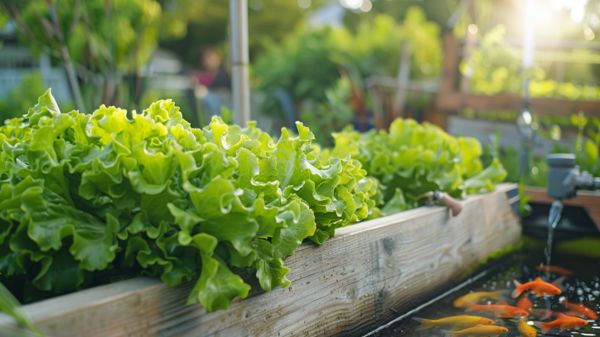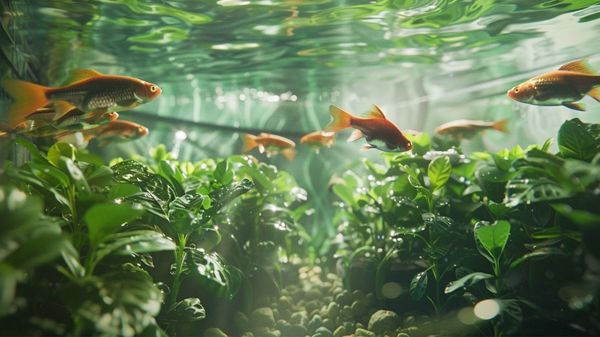Designing a small-scale aquaponics system offers a sustainable solution to urban gardening challenges, combining aquaculture with hydroponics in a symbiotic environment.
Key considerations involve selecting an appropriate location that accommodates both a fish tank and a plant grow bed, ensuring that the system’s design effectively promotes water recirculation and filtration to support both aquatic life and plant growth.
By choosing suitable species of fish and plants that thrive in similar water conditions, enthusiasts can optimize their system’s productivity. However, the intricacies of balancing water quality parameters, which are vital for the health of the system, pose a complex challenge.
Understanding Aquaponics Basics
Aquaponics integrates aquaculture and hydroponics to create a self-sustaining environment where fish waste serves as a nutrient source for plants, which in turn purify the water for the fish.
This innovative system harnesses the nitrogen cycle, where fish excrete ammonia that is then converted into nitrites and ultimately nitrates by beneficial bacteria. These nitrates, essential for plant nutrition, are absorbed by the plants located in the grow bed.
In a small-scale aquaponics system, the balance between the fish, plants, and bacteria is significant. The system’s design must guarantee that the water, enriched with nutrients from the fish waste, flows efficiently into the grow bed.
Here, the roots of the plants uptake the nutrients, simultaneously filtering and cleansing the water, which is then recirculated back to the fish tank. This closed-loop system minimizes water usage and creates an ideal environment for both fish and plant growth.
Key components such as the fish tank, grow bed, water pump, and aeration system must be configured to support the continuous movement of water and the sustenance of beneficial bacteria.
These elements are engineered to work cohesively, guaranteeing the system remains balanced and productive, empowering individuals to cultivate food independently and sustainably.
Planning Your System Setup
To effectively plan your aquaponics system setup, first measure the available space on your desk to determine the appropriate dimensions for both the fish tank and grow bed.
Given the constraints of a small-scale aquaponic system, guaranteeing a sturdy and level surface is essential to support the weight and operation of the system components effectively.
Next, consider the placement of energy-efficient LED grow lights. These are important for plant growth, particularly in areas without sufficient natural light. Position the lights to evenly cover the grow bed while avoiding direct exposure to the fish tank to manage algae growth and maintain ideal water quality.
Accessibility is key for routine maintenance. Position your system near electrical outlets for easy connection of the submersible water pump and lights. Ascertain that the system’s location allows comfortable access for feeding fish and monitoring water quality.
Choosing the right grow bed is critical. It must facilitate proper drainage and accommodate the necessary water flow. Preparation involves drilling holes and connecting flexible tubing that links the bed to the fish tank.
You should seize this tubing to match the pump’s capacity, guaranteeing efficient water circulation and oxygenation, important for both plant and fish health.
Selecting Fish and Plants
After establishing the physical setup of your aquaponics system, the next vital step involves selecting appropriate fish and plants to guarantee a balanced and thriving environment.
In selecting fish, it is essential to focus on hardy species that can tolerate the intricacies of a confined aquatic environment. Species such as goldfish, guppies, and angelfish are best for their resilience and suitability for beginners. These species provide a steady supply of nutrient-rich water, essential for plant growth.
It is also important to adhere to a proper stocking density; approximately one pound of fish per 10 gallons of water is ideal to maintain the health of the aquatic ecosystem without overburdening the system.
For plant selection, leafy greens such as lettuce, spinach, and various herbs are preferable. These plants thrive in aquaponics systems due to their shallow root systems, which do not require extensive space and are efficient in nutrient uptake.
Additionally, when considering the lighting conditions of your setup, select plant varieties that can prosper in low-light environments if sunlight exposure is limited.
Starting these plants in grow cubes or a suitable loose growing medium can facilitate robust root development, allowing them to utilize the available nutrients effectively and contribute to the sustainability of the aquaponics system.
Related Post: The Best Fish for Small Aquaponics System You Need to Consider.
Gathering Necessary Materials
Selecting the right materials is imperative for building an efficient and sustainable aquaponics system.
Begin with a fish tank, opting for a durable glass or acrylic container with a capacity between 5-20 gallons, which can adequately support the weight of the water. Match this with a shallow grow bed crafted from sturdy plastic trays or repurposed containers. Ascertain the grow bed has sufficient drainage holes to maintain ideal water flow, essential for preventing waterlogging and guaranteeing the health of the system.
Next, select a submersible water pump rated between 30-100 gallons per hour. An adjustable flow rate is critical as it allows for precise control over the water circulation between the fish tank and the grow bed.
Connect the pump to the grow bed using food-safe, flexible tubing. The tubing diameter should match the pump outlet to guarantee efficient water transfer without any restrictions.
Related Post: 8 Best Indoor Aquaponics Fish Tank Systems for Sustainable Home Gardening.
System Maintenance and Benefits
Maintaining a small-scale aquaponics system requires diligent daily, weekly, and monthly tasks to guarantee peak operation and health of both the fish and plants.
Daily routines should focus on feeding the fish and monitoring the aquaponics system’s water flow and pump function. It’s vital to observe the health of the fish and plants, ensuring there are no signs of nutrient deficiencies which could signal imbalances in the system.
Weekly, you must test the water quality for parameters like ammonia, nitrites, nitrates, and pH levels. These factors are essential for the survival of beneficial bacteria that convert harmful fish waste into beneficial nutrients for plant production. Regular cleaning of the tank and grow bed is necessary to prevent the accumulation of debris, which can affect water quality and the efficiency of the system.
Monthly, you should perform a more thorough cleaning and a partial water change, typically 10-20% of the total volume to maintain clean water and ideal environmental conditions.
The benefits of such rigorous system maintenance are manifold. An efficiently running aquaponics system provides a constant supply of fresh herbs and leafy greens, reduces grocery costs, enhances biodiversity, and fosters a sustainable relationship between aquatic and plant life.
Conclusion
In summary, designing a small-scale aquaponics system encompasses understanding fundamental principles, meticulous planning, and careful selection of compatible aquatic and plant species.
Key components include a durable fish tank, efficient water pump, and LED grow lights to guarantee system efficiency and plant health. Regular maintenance and monitoring are essential for sustained success.
The integration of these elements not only optimizes resource use but also promotes sustainable agricultural practices, offering significant environmental and nutritional benefits.




